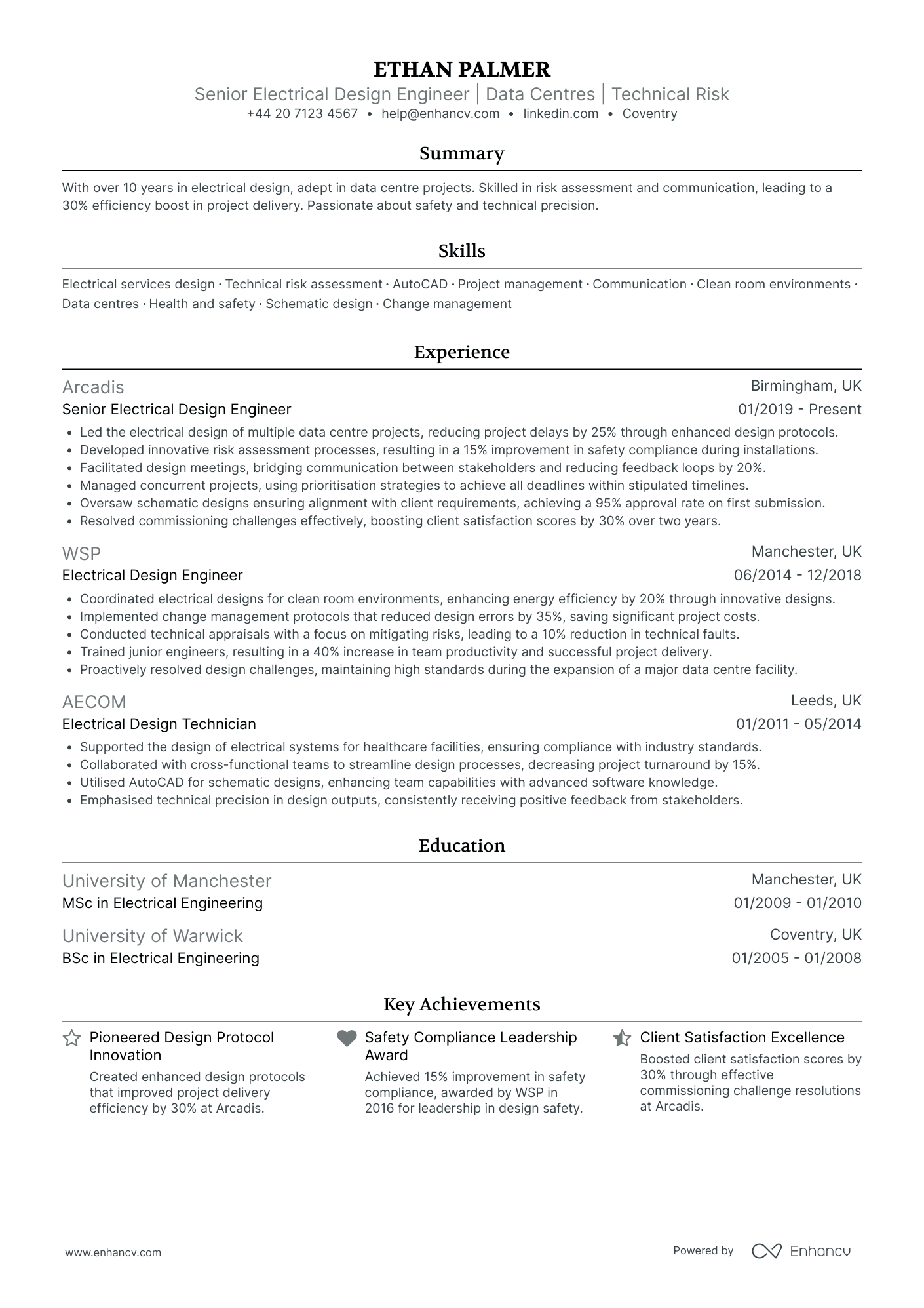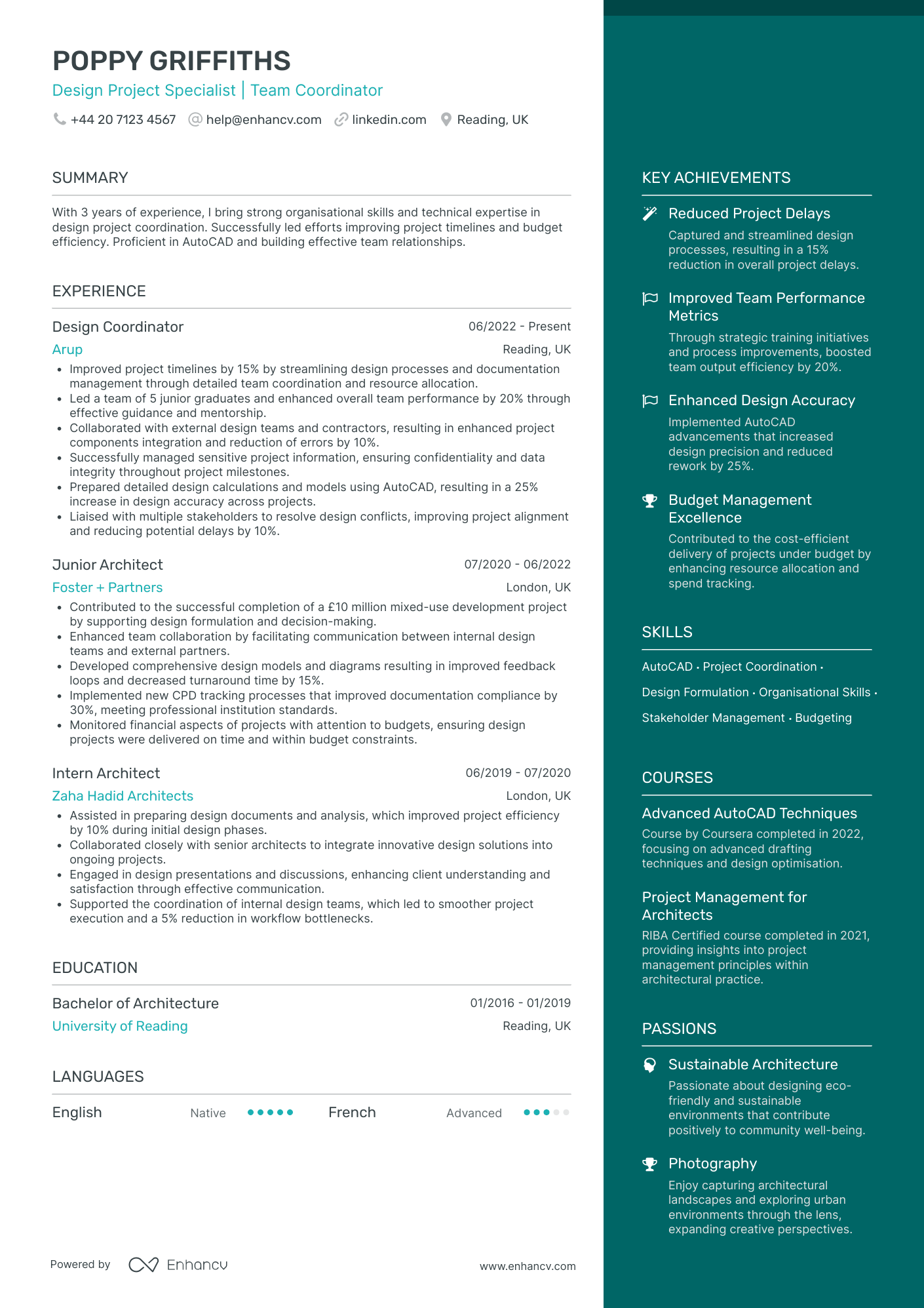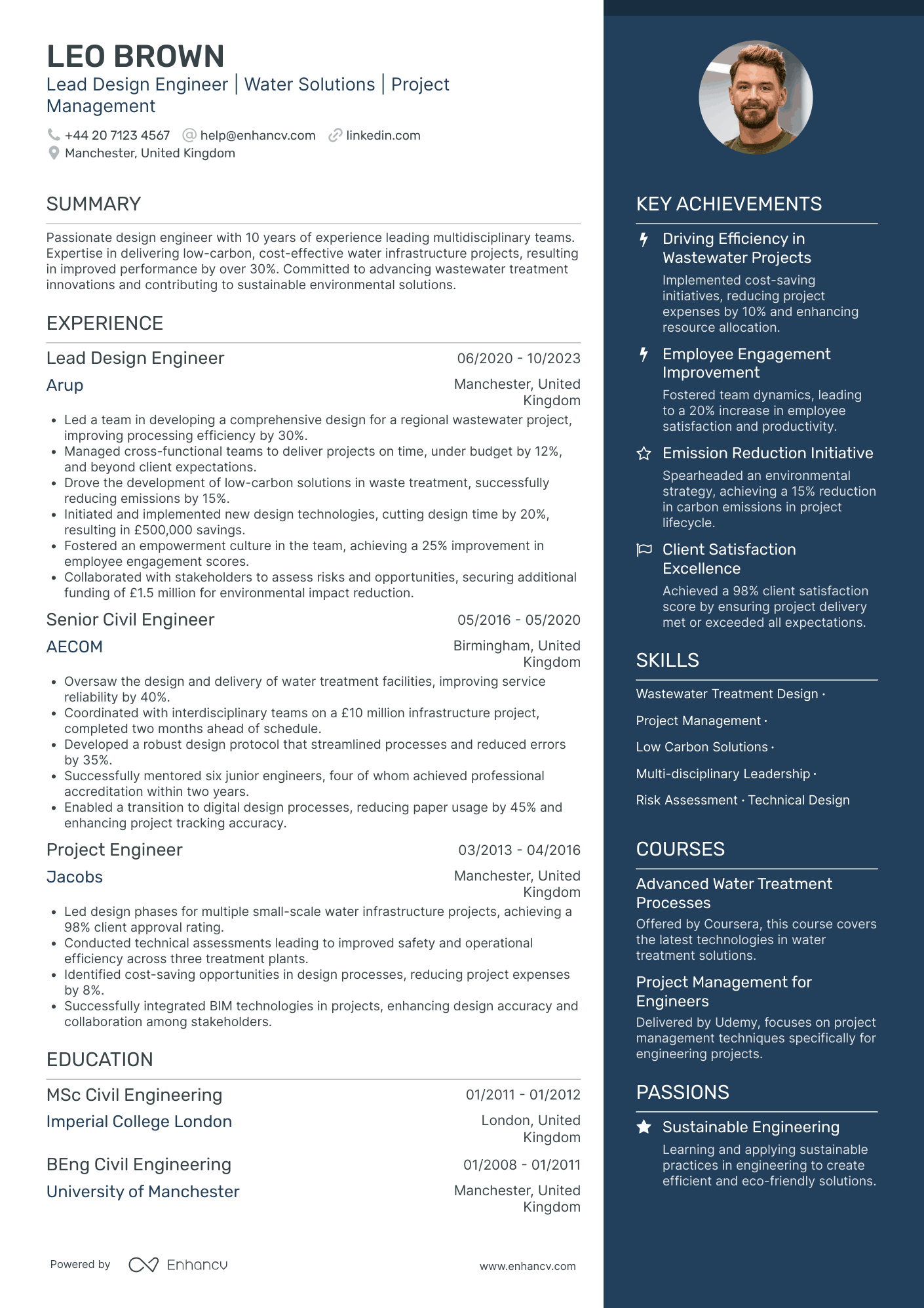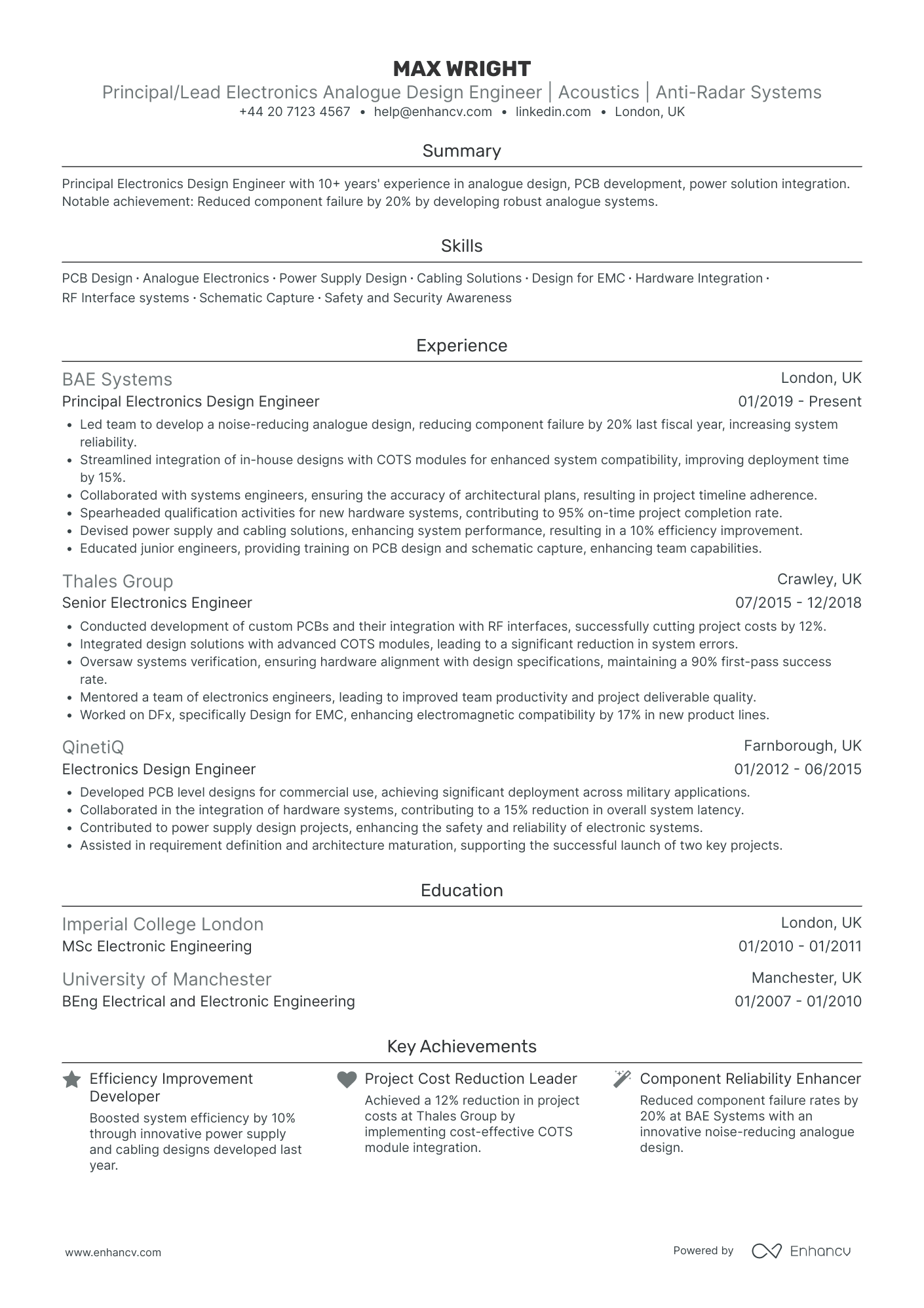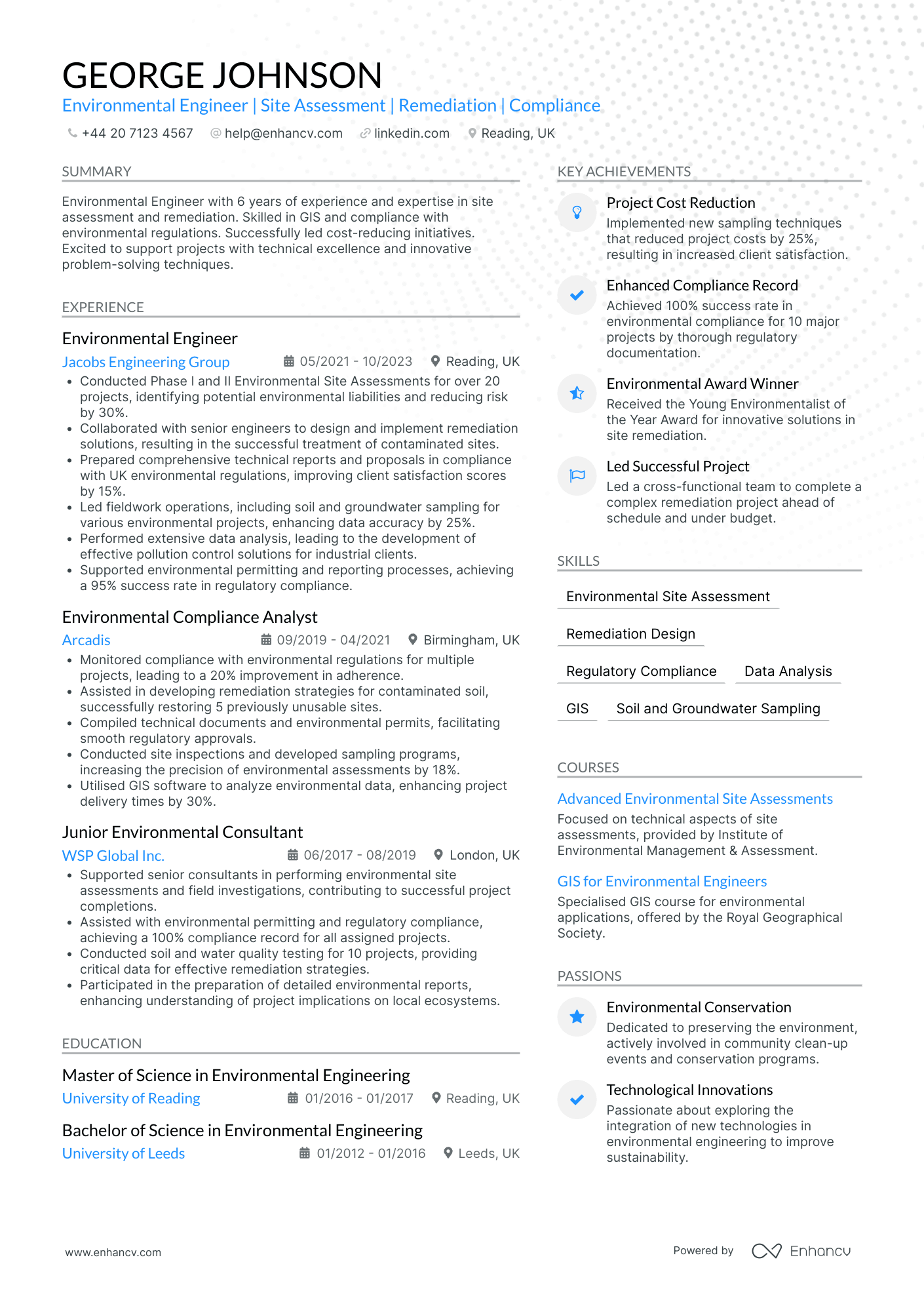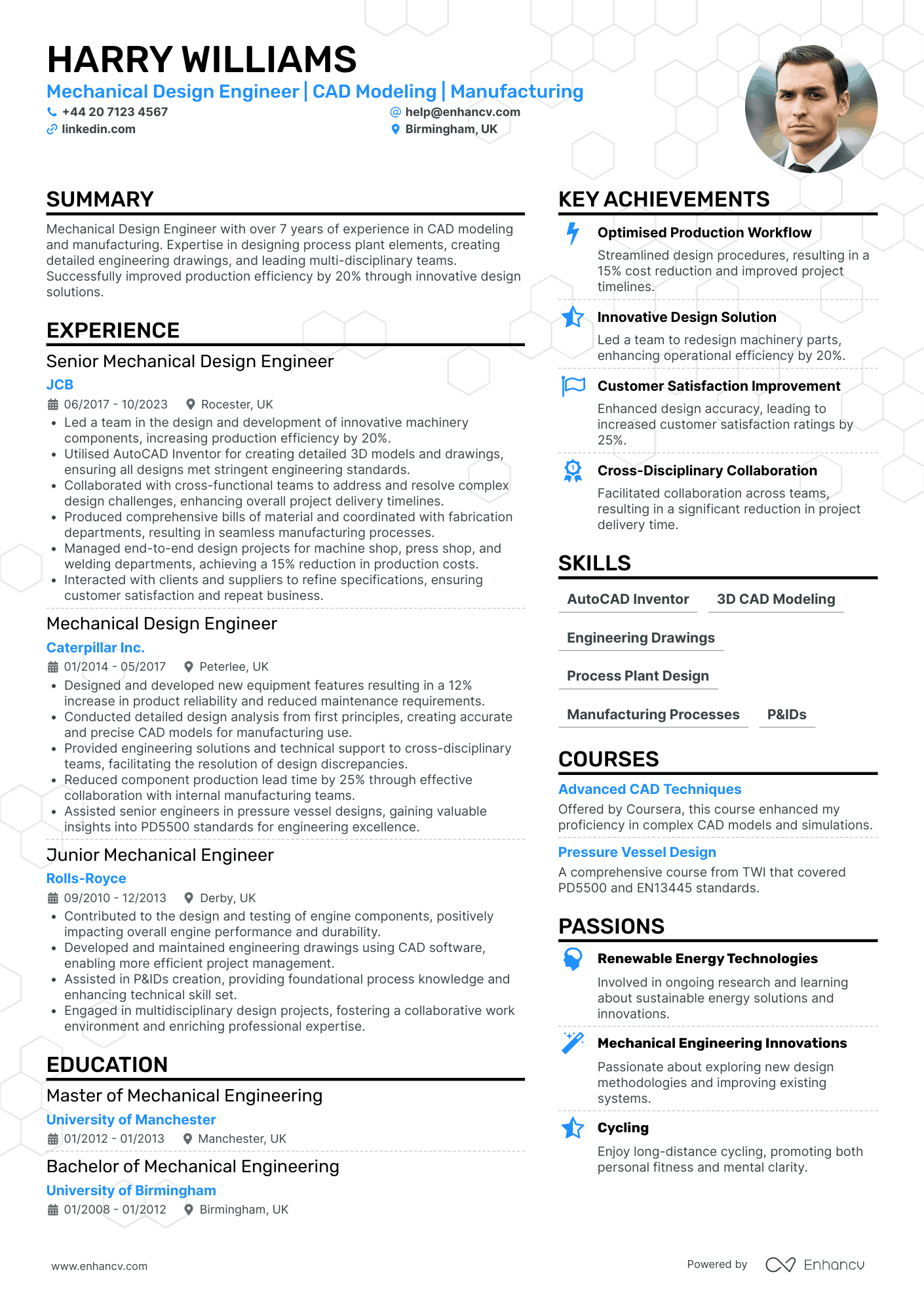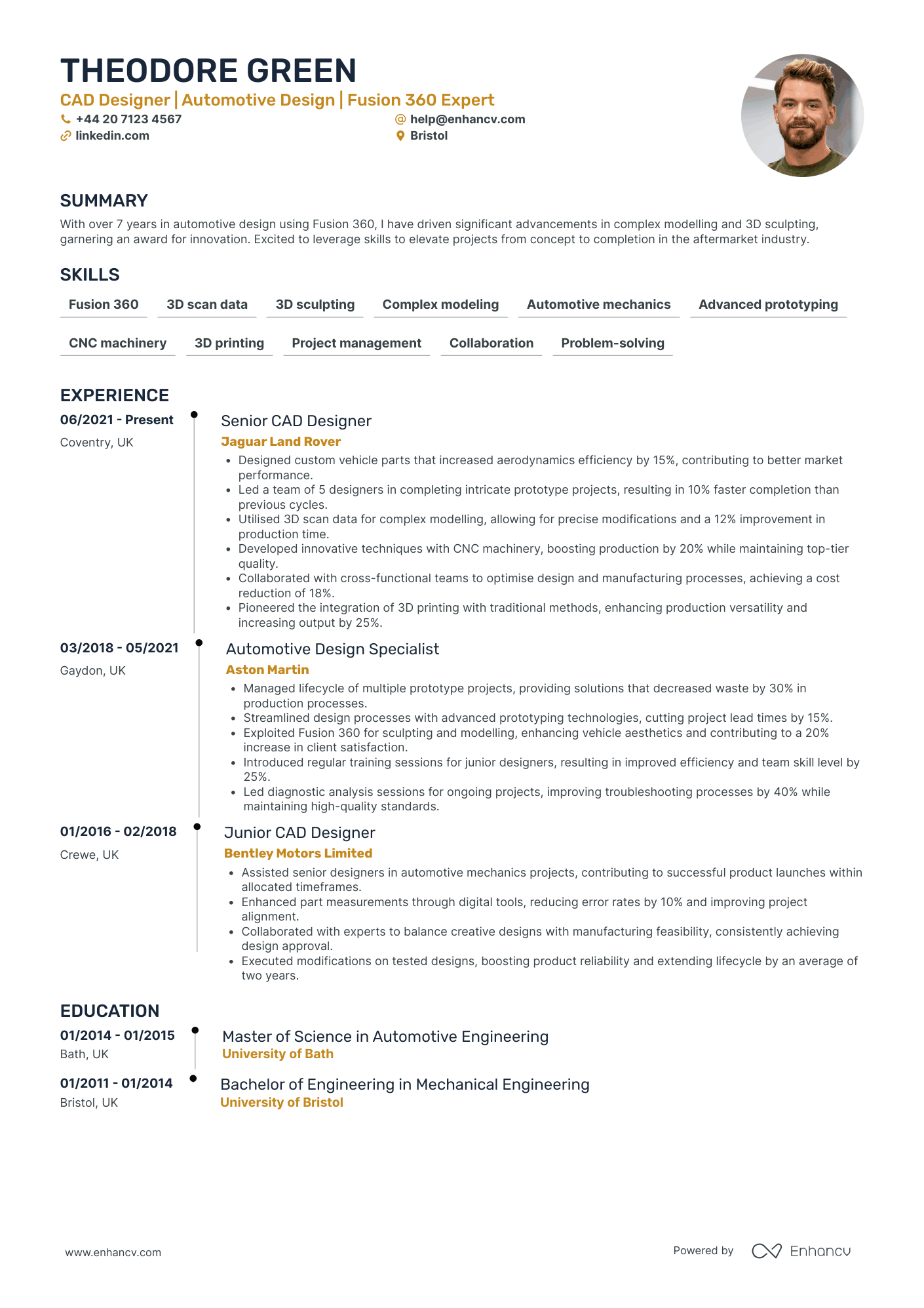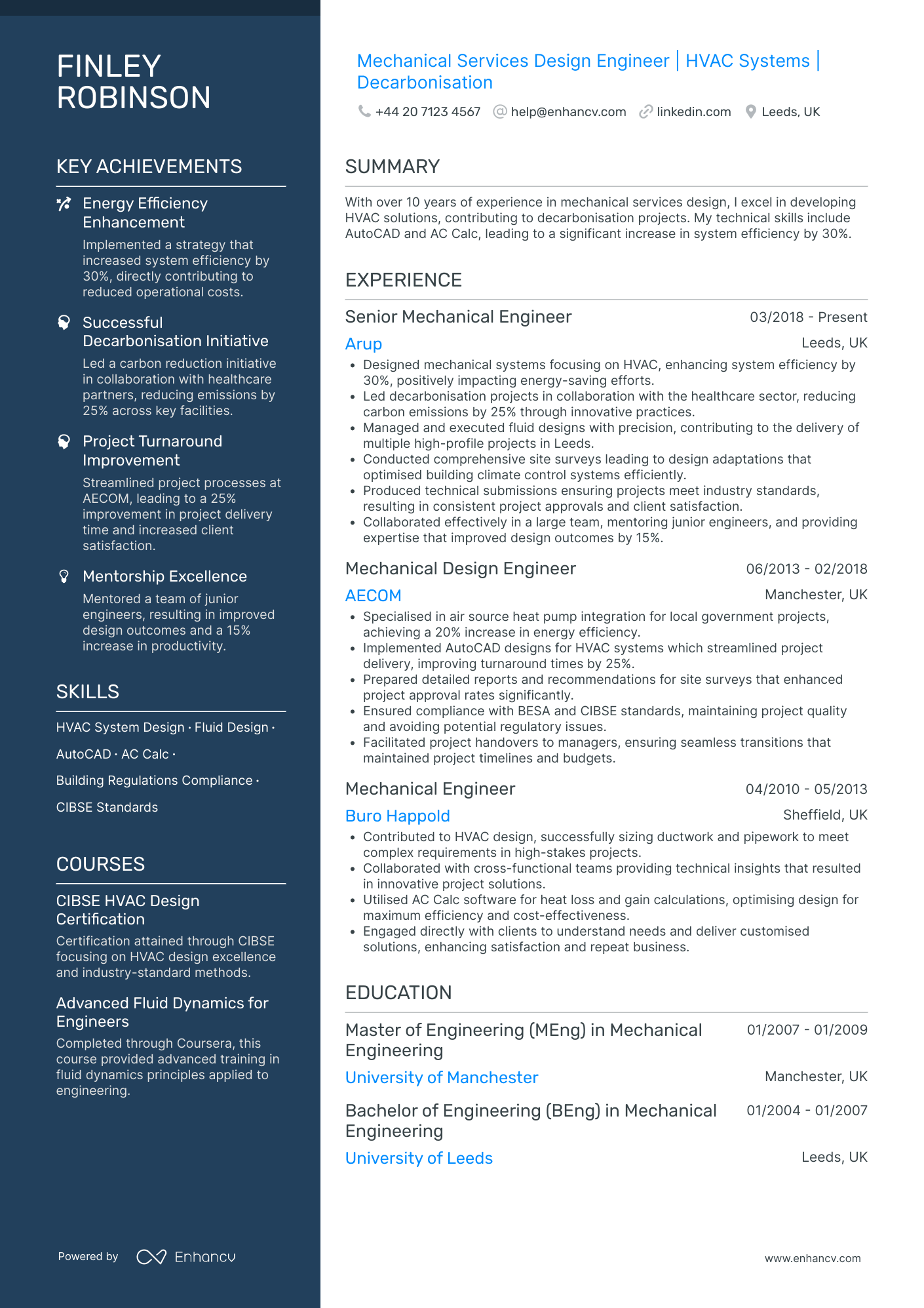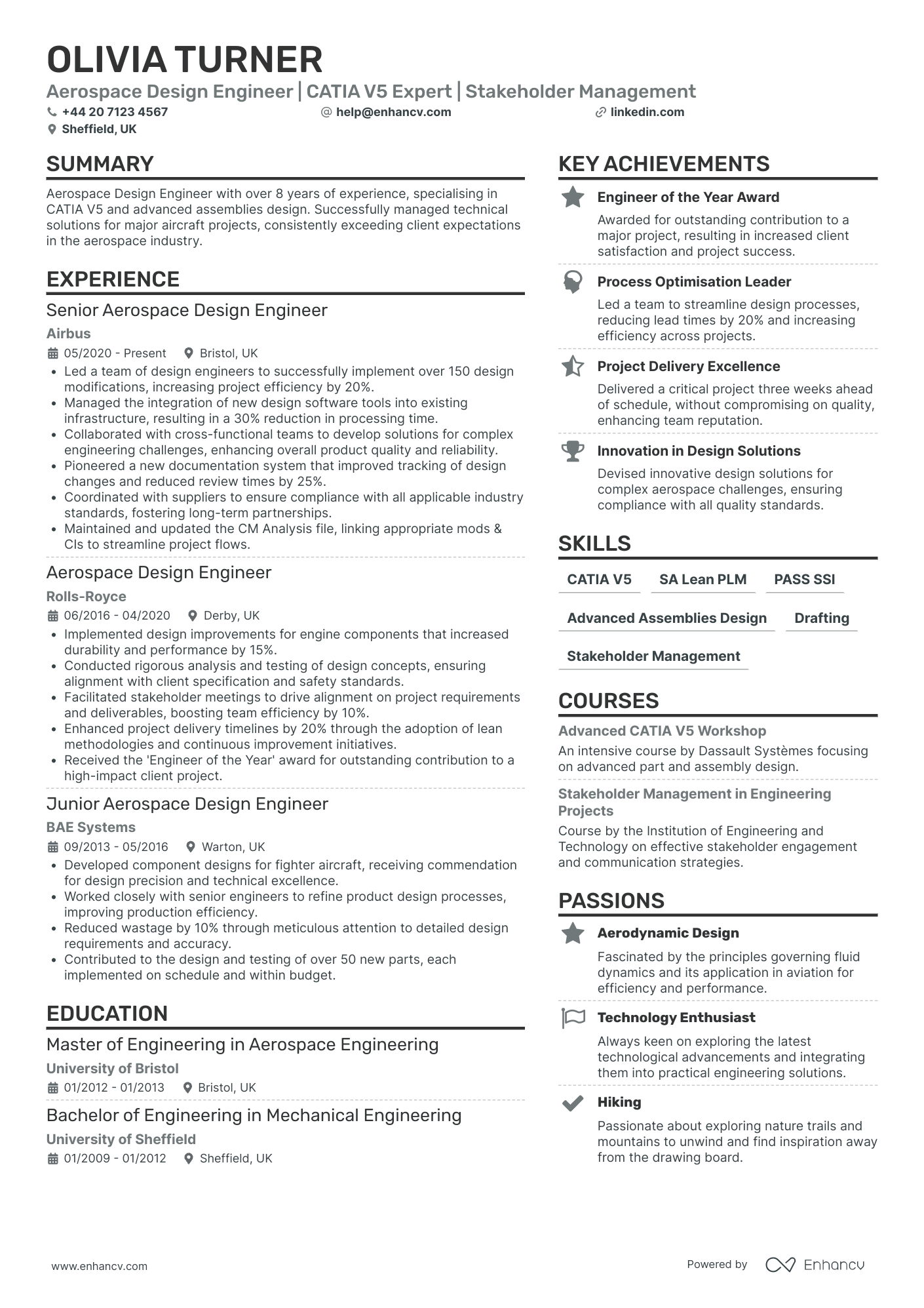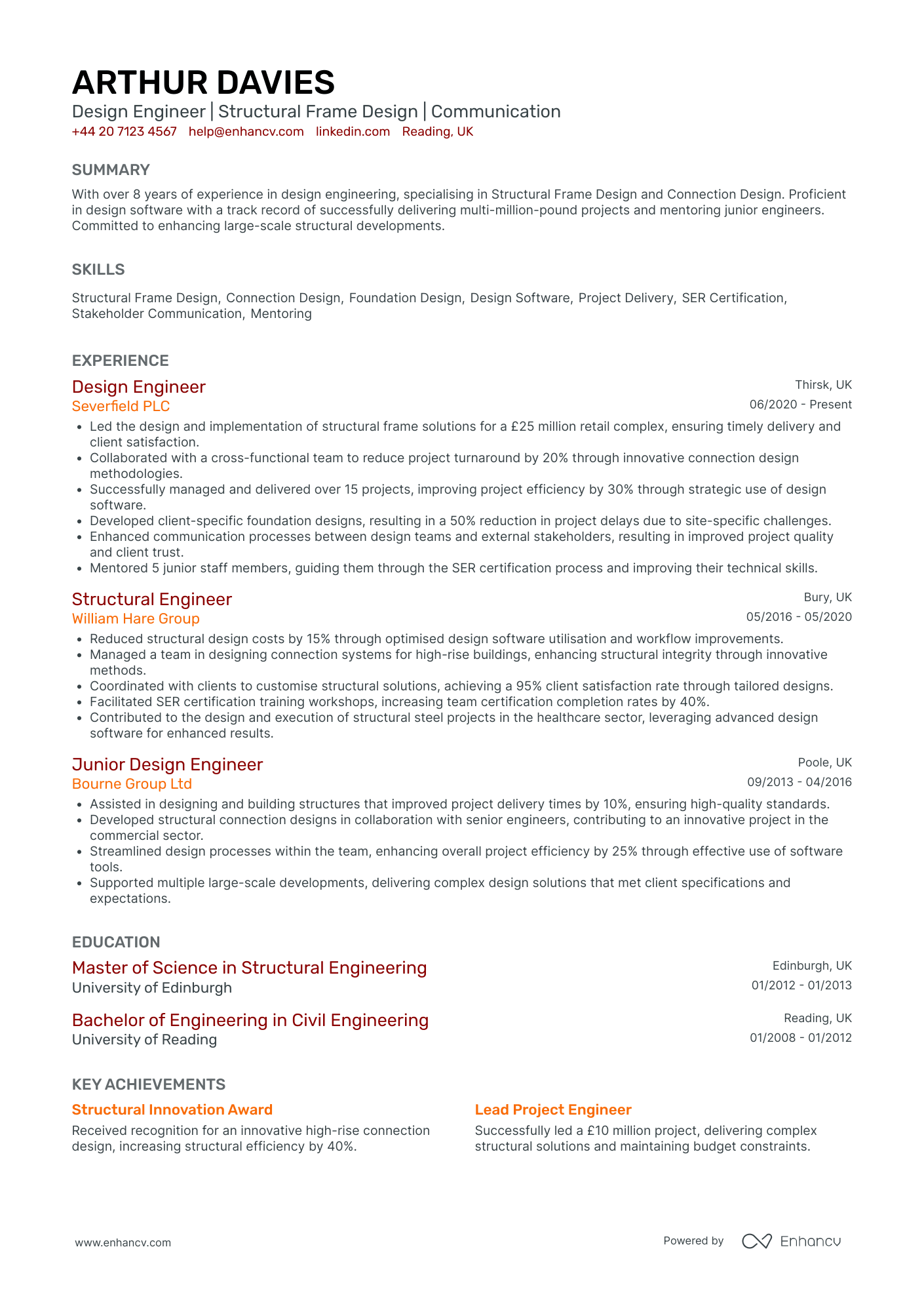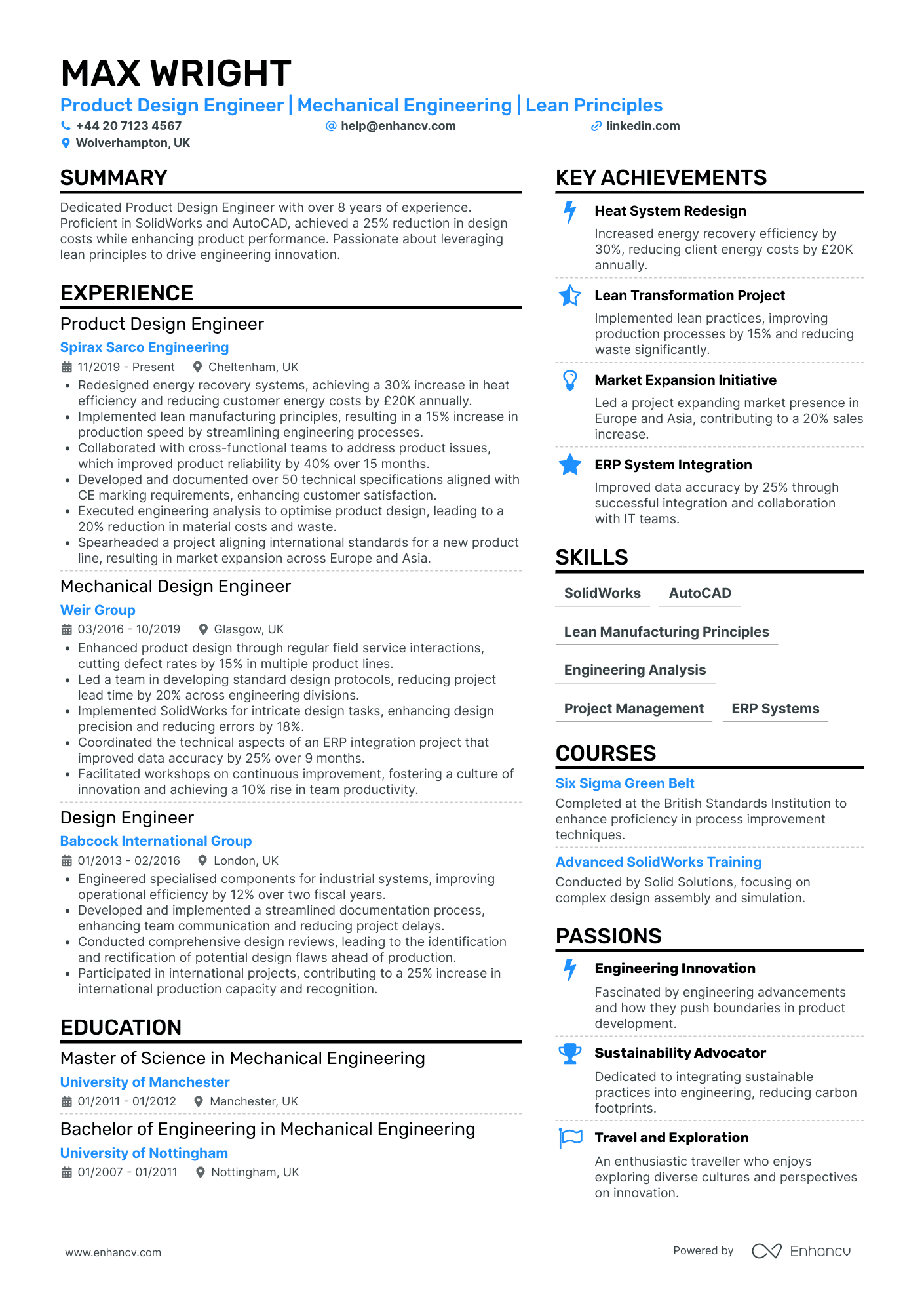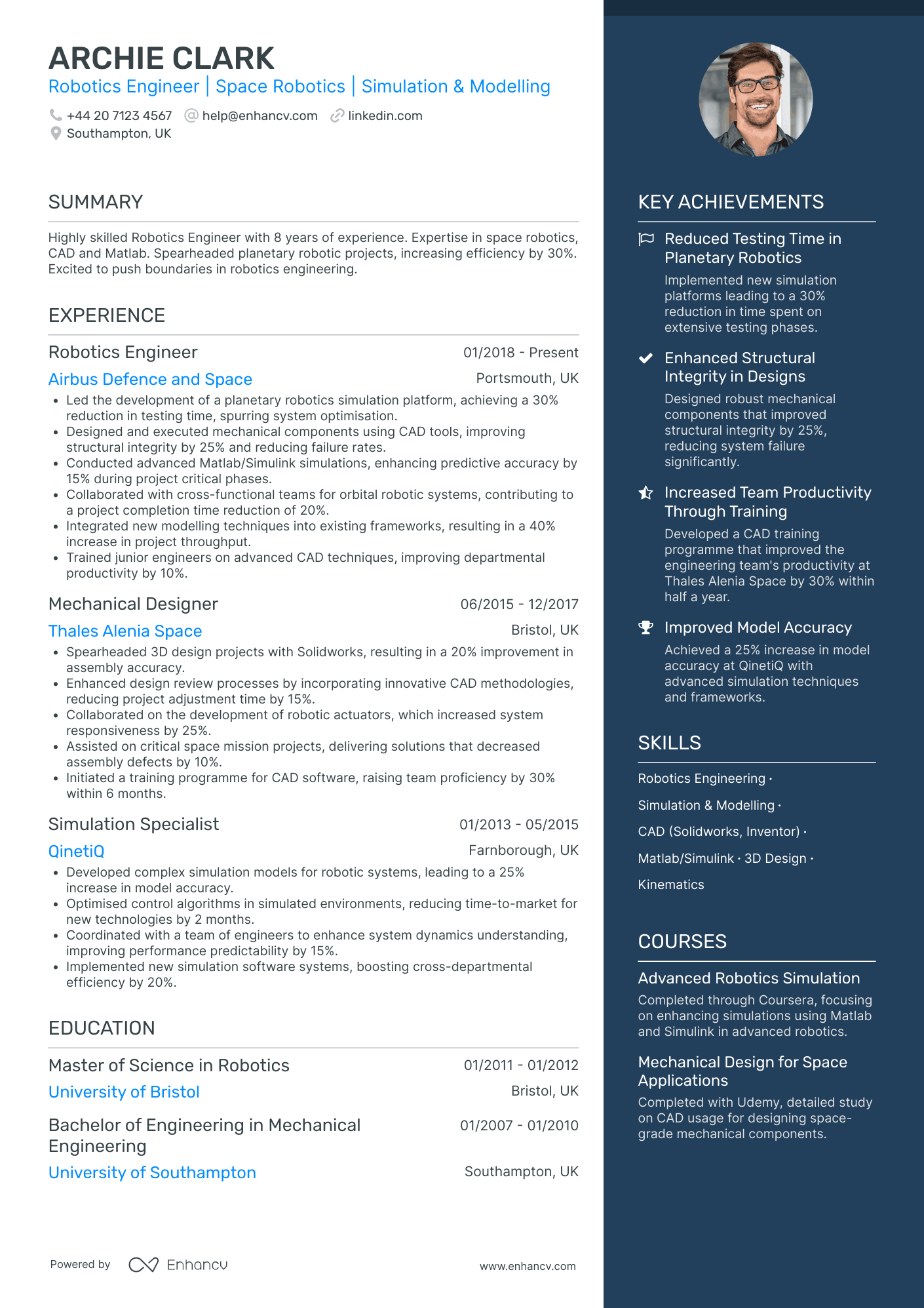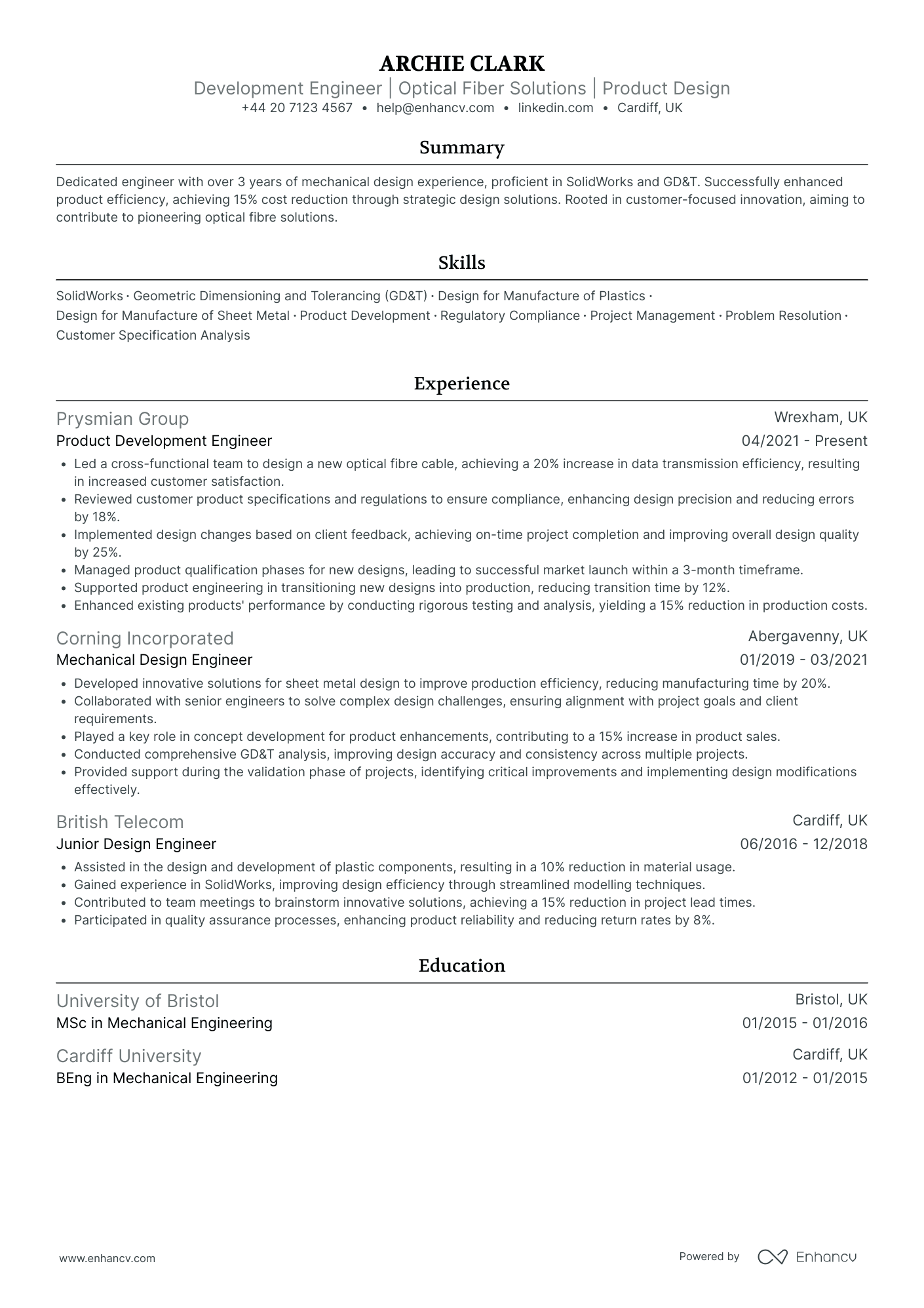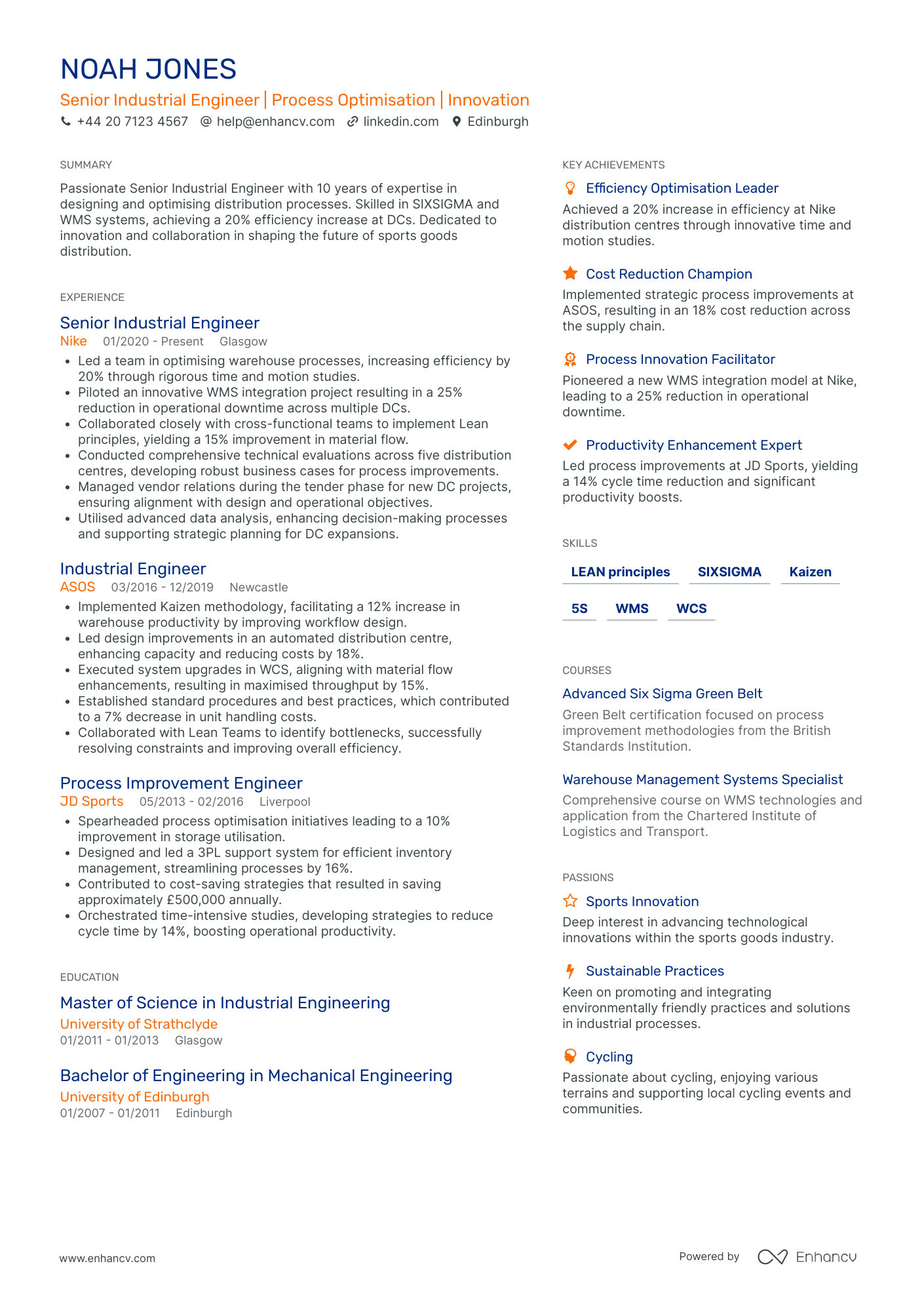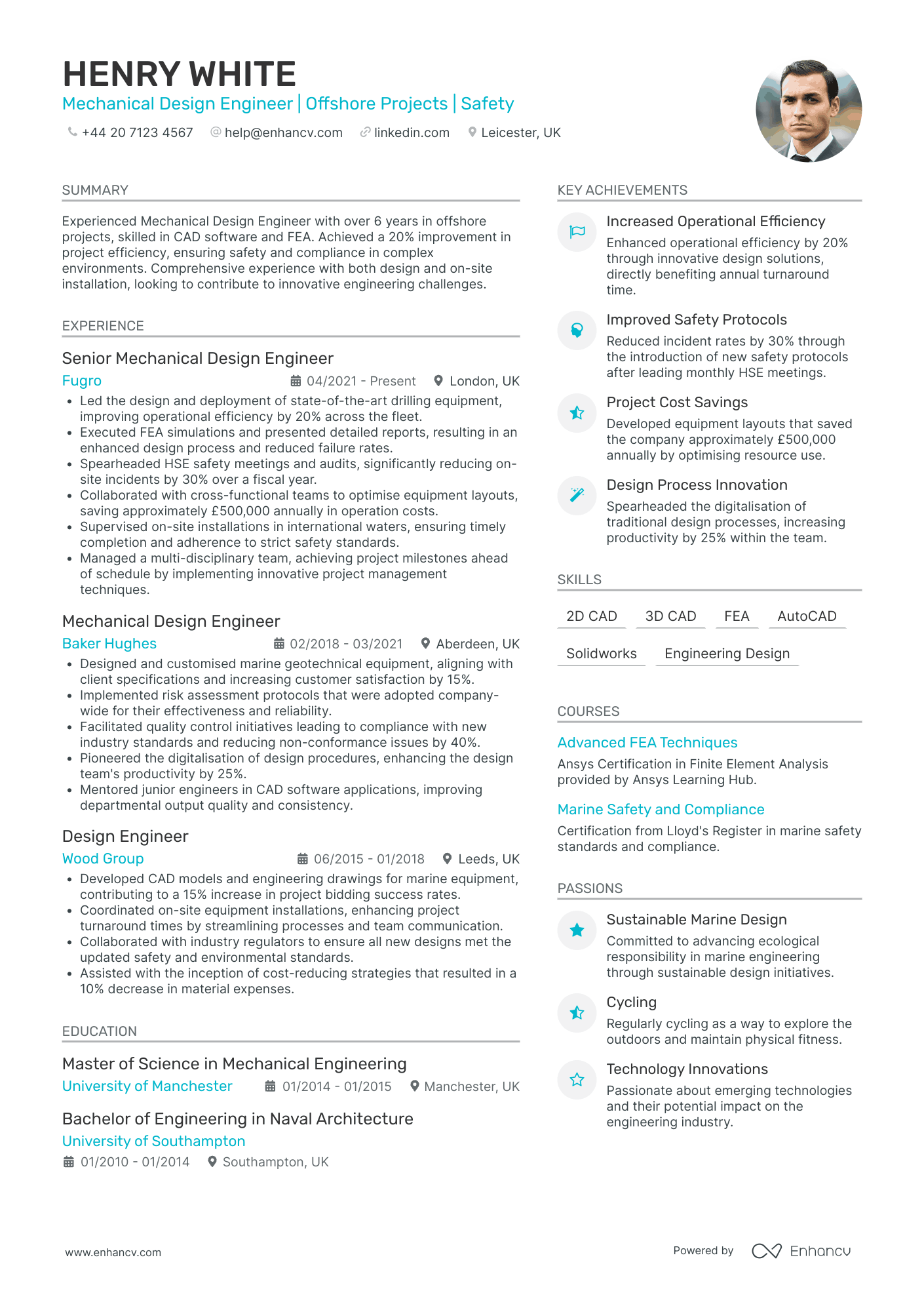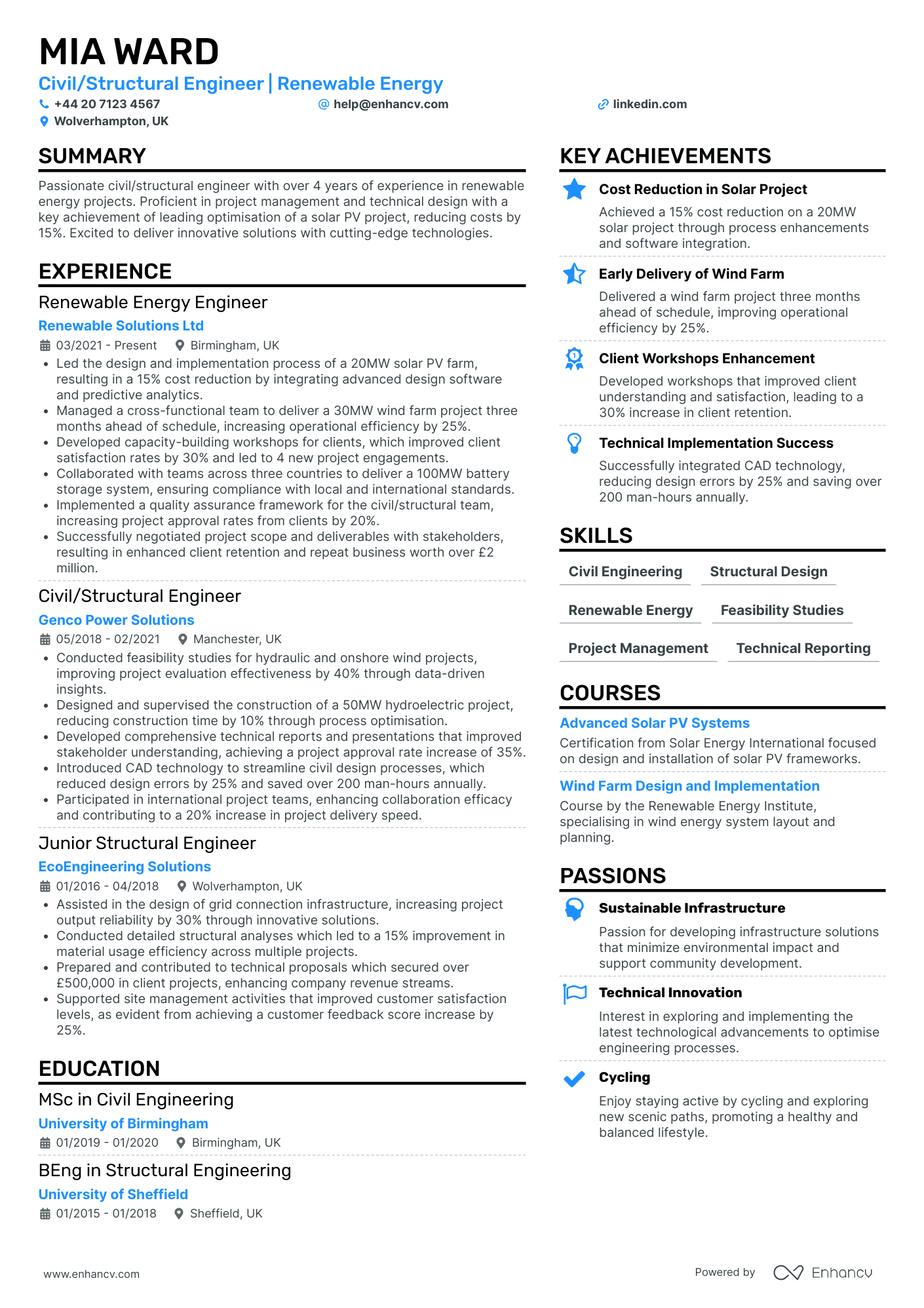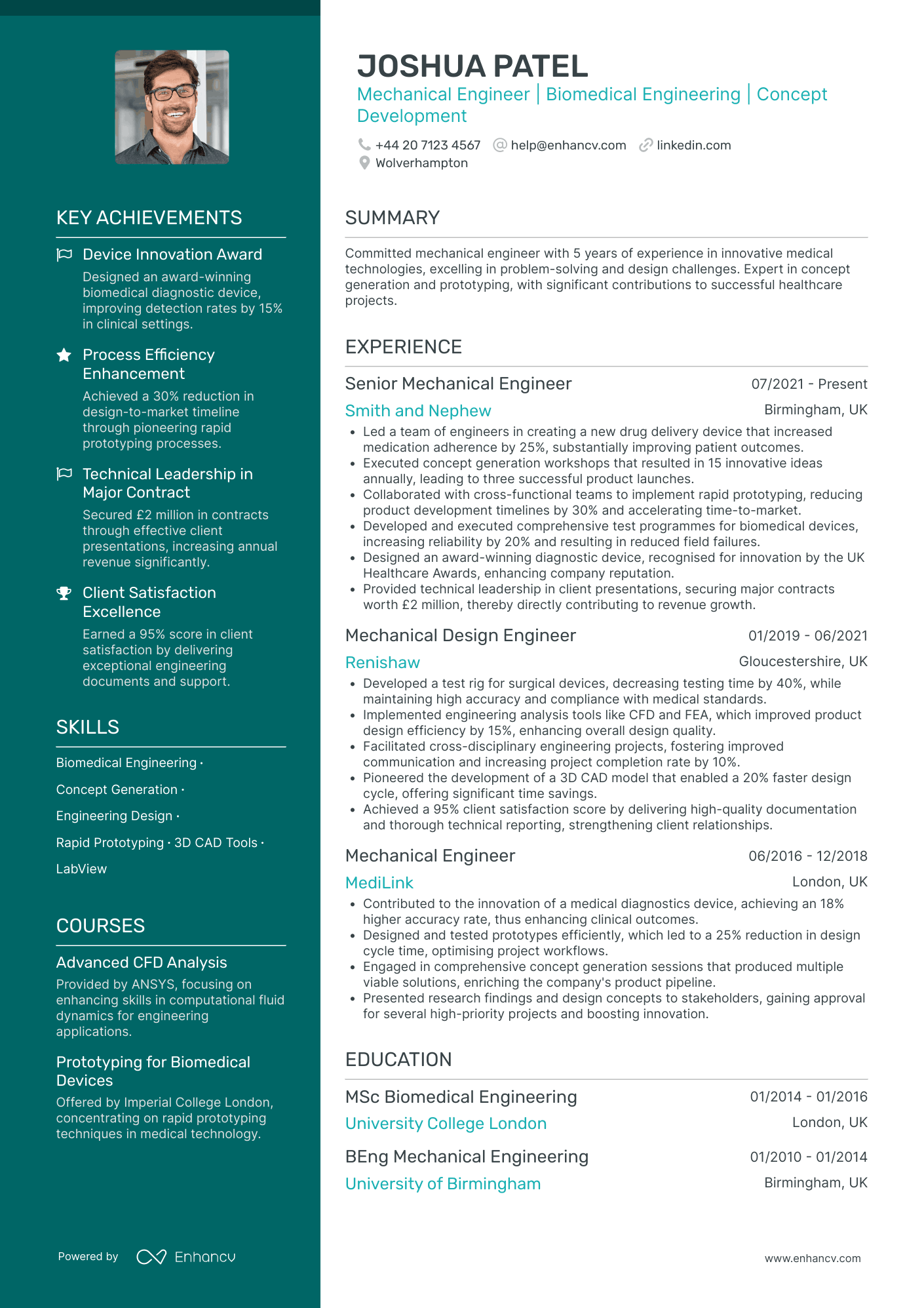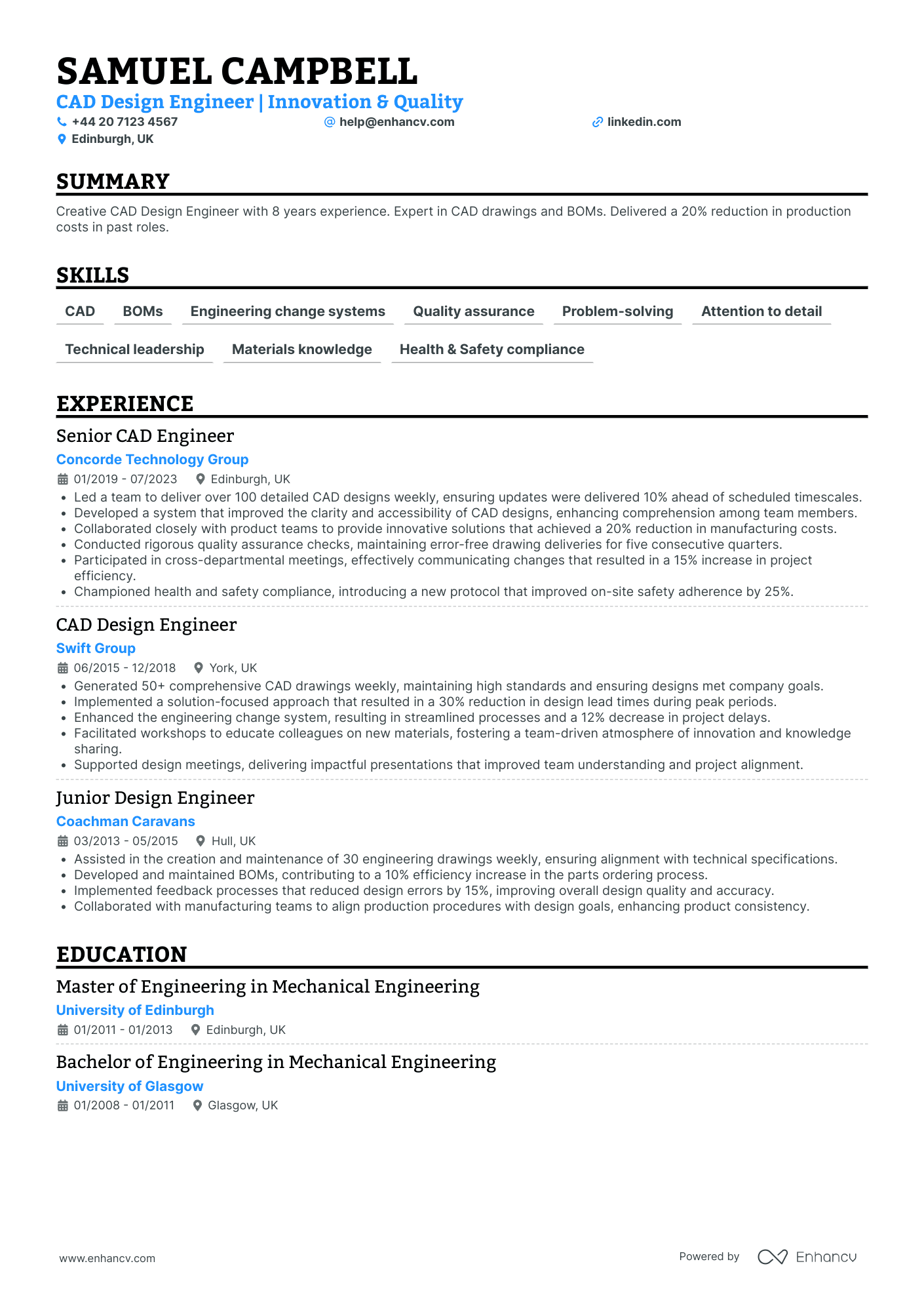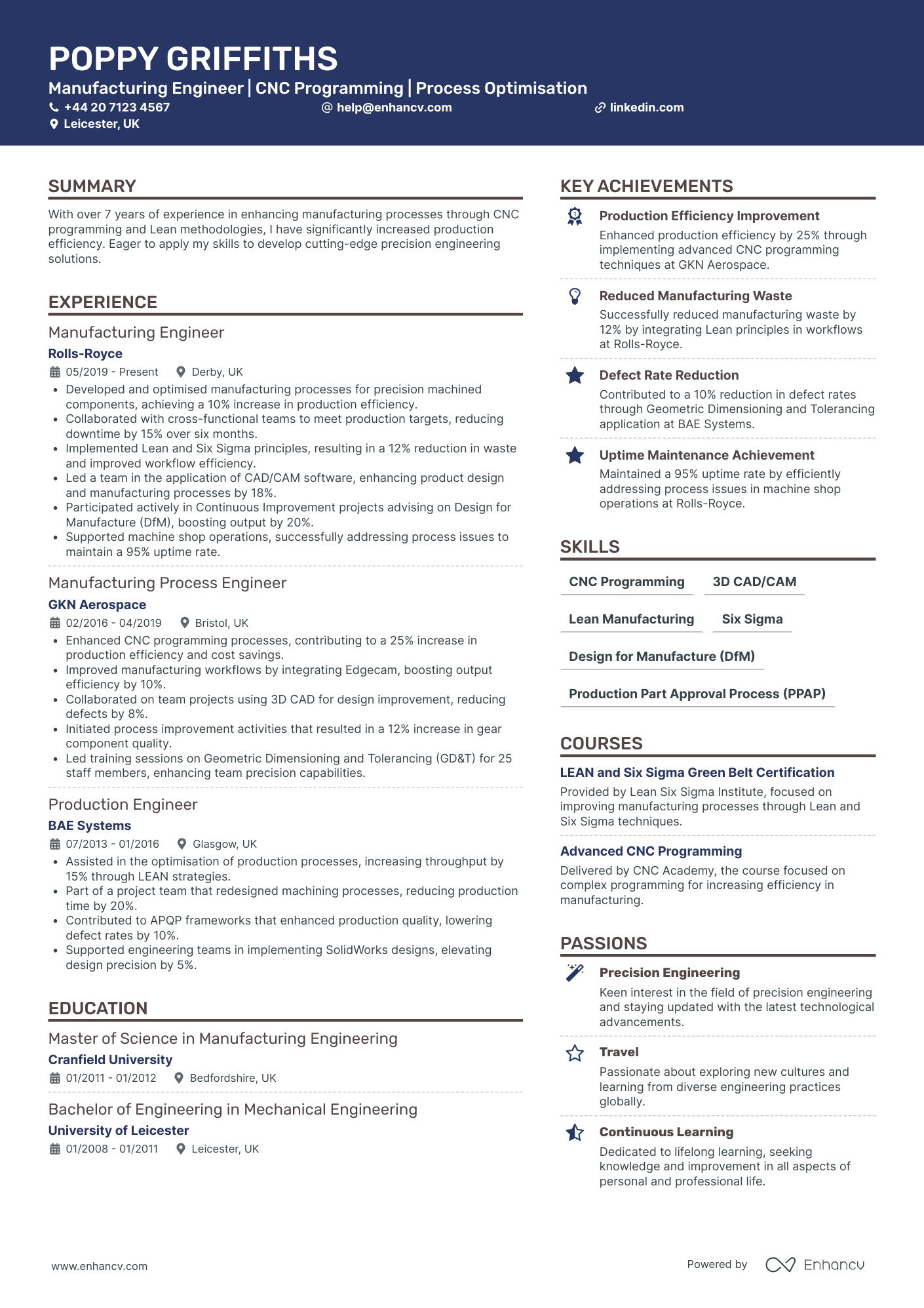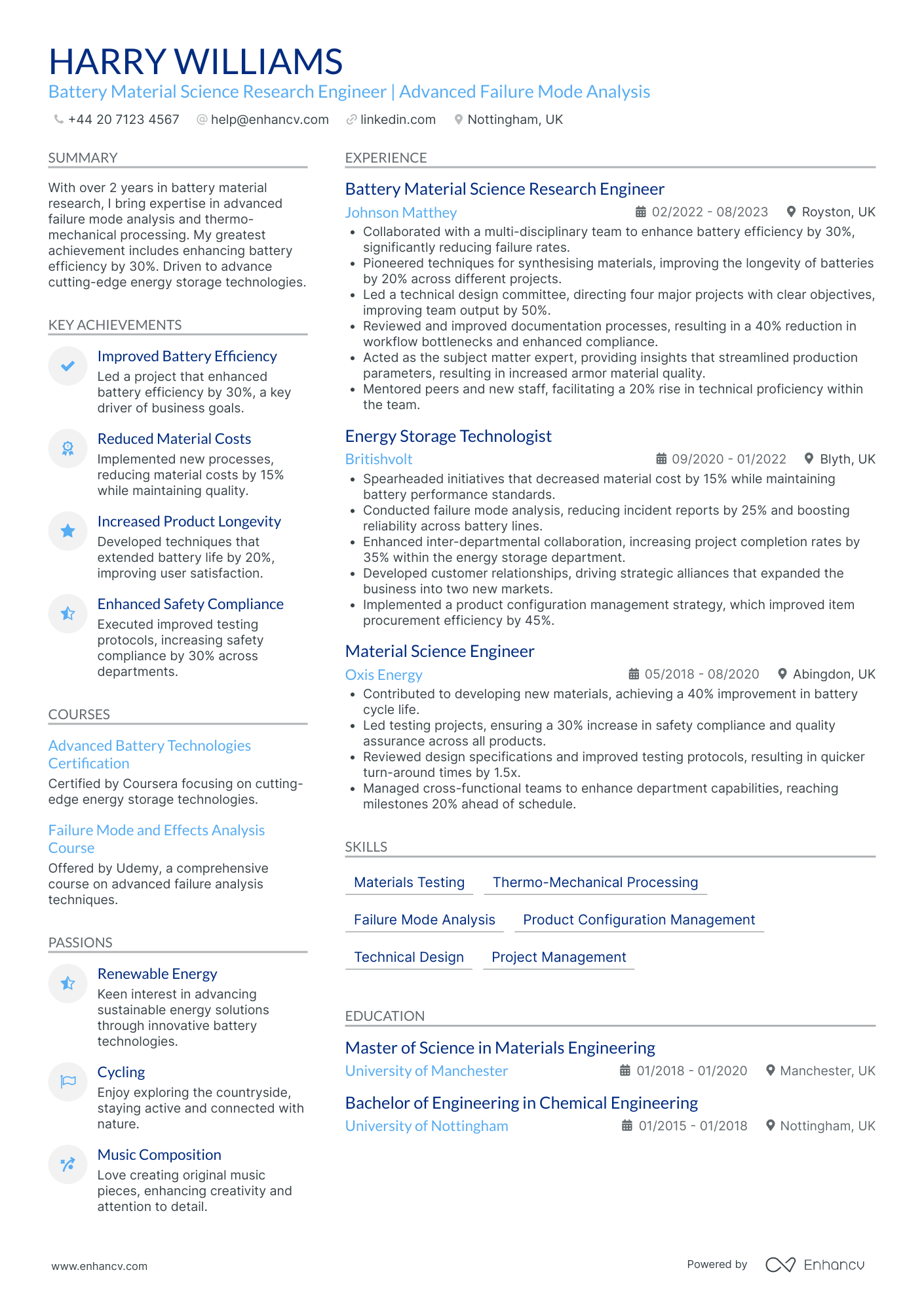One particular CV challenge you might encounter as a design engineer is effectively showcasing your project experience to highlight both your technical expertise and creativity. Our guide provides tailored advice on structuring your CV and employing powerful language to ensure your unique contributions stand out to potential employers.
- Create an attention-grabbing header that integrates keywords and includes all vital information;
- Add strong action verbs and skills in your experience section, and get inspired by real-world professionals;
- List your education and relevant certification to fill in the gaps in your career history;
- Integrate both hard and soft skills all through your CV.
Discover more industry-specific guides to help you apply for any role in the links below:
Resume examples for design engineer
By Experience
Senior Electrical Design Engineer
- Structured and Detail-Oriented Presentation - The CV is structured with clear sections, making it easy to follow the candidate's professional journey. It employs bullet points effectively for concise communication of responsibilities and achievements, ensuring the reader can quickly grasp the candidate's expertise and contributions.
- Analyzes Career Growth and Industry Specialization - Ethan Palmer's career trajectory showcases steady growth from Electrical Design Technician to Senior Electrical Design Engineer. His consistent rise indicates a deep specialization in data centers and technical risk management, underlined by his transition through different companies and increasing responsibilities.
- Showcases Technical Expertise and Industry Acumen - The CV highlights industry-specific skills and methods, such as leading electrical designs and innovative risk assessment processes in data centers. It emphasizes Ethan's proficiency with tools like AutoCAD and design protocols, underlining his ability to innovate and improve operational efficiencies.
Junior Structural Design Engineer
- Clear and structured presentation - The CV is well-organized, allowing for easy navigation through distinct sections such as Summary, Experience, Education, and Skills. Each part is clearly labeled, enhancing readability and ensuring that the candidate’s key qualifications and experiences are prominently highlighted. Conciseness is maintained by focusing on relevant details and avoiding unnecessary information.
- Progressive career trajectory - Poppy Griffiths demonstrates a consistent upward career progression, moving from roles like Intern Architect to Design Coordinator. This trajectory showcases her development and increased responsibility over time, indicating a strong professional growth within the architectural and design fields. It also highlights promotions and advancements that align with her skills and achievements.
- Technical depth in the design field - The CV emphasizes proficiency in industry-specific tools and methodologies, such as AutoCAD, GSA, ETABS, and SAFE. This technical expertise is crucial, especially in design project coordination, where precise calculations and model accuracy are paramount. Additionally, her advanced course in AutoCAD techniques further reinforces her technical skills.
Lead Civil Design Engineer
- Clear Structure and Concise Content Presentation - The CV of Leo Brown opens with a well-organized header, includes a comprehensive summary, and is structured into clearly defined sections such as experience, education, skills, and achievements. This format ensures that the reader can quickly grasp the most important aspects of his career while maintaining conciseness throughout the document. Every bullet point in the experience section is impactful and uses precise language, ensuring clarity and brevity.
- Consistent Growth and Specialized Expertise in Water Solutions - Leo's career trajectory showcases consistent growth from a Project Engineer to a Lead Design Engineer within a decade. His career path reflects not only his technical proficiency but also his progression into leadership roles, with each position demonstrating an increased scope of responsibility. His focus on water infrastructure projects indicates a deep specialization in this critical industry, a unique strength that distinguishes his profile.
- Leadership and Cross-Disciplinary Collaboration - The CV illustrates Leo's strong leadership capabilities, notably his experience in managing and empowering interdisciplinary teams to achieve significant improvements in project outcomes. This is complemented by his ability to foster an empowering culture and improve employee engagement, crucial soft skills for enhancing team dynamics. His success in securing additional funding by collaborating with stakeholders further underscores his adeptness in cross-disciplinary collaboration, essential for advancing complex projects.
Principal Design Engineer in Electronics
- Shows a progressive career trajectory - The candidate has demonstrated steady growth from an Electronics Design Engineer to a Principal Electronics Design Engineer. This progression indicates a solid career path and the ability to take on increased responsibilities, reflecting both dedication and capability in their field.
- Strong emphasis on industry-specific skills and tools - The CV showcases expertise in analogue electronics design, PCB development, and power solutions integration, which are critical in the high-tech sector. It highlights proficiency with RF interfaces and design for electromagnetic compatibility, underscoring the candidate’s technical depth and capability to handle complex engineering challenges.
- Emphasizes leadership and mentoring capabilities - The candidate has not only led teams to reduce system failures and improve project timelines but also focused on mentoring junior engineers, which adds depth to their leadership profile. This ability to nurture talent and enhance team productivity is crucial for roles that require team management and development.
Entry-Level Environmental Design Engineer
- Comprehensive Career Progression - George Johnson's CV presents a clear and logical career trajectory from a Junior Environmental Consultant to an Environmental Engineer. Each role showcases his increasing responsibilities, such as designing remediation solutions and leading fieldwork operations, which underscores his growth and dedication within the environmental engineering field.
- Variety of Industry-Specific Skills - The CV is rich in industry-specific elements, highlighting George's proficiency in tools like GIS software and methodologies like environmental site assessments and remediation design. His technical depth is evident through the quantifiable impact of his work, including a 30% reduction in environmental liabilities, which speaks to his expertise and innovation.
- Achievements with Clear Business Impact - George's achievements go beyond mere numbers and reflect substantial business benefits. For instance, he implemented new sampling techniques that resulted in a 25% cost reduction for projects, boosting client satisfaction. This ability to enhance operational efficiency and compliance demonstrates his strategic value to employers in the environmental sector.
By Role
Mechanical Design Engineer
- Effective Content Layout - The CV's structure is logically organized, starting from personal summary to accomplishments, providing a seamless reading experience. Each section is clearly labeled and utilizes bullet points for key details, ensuring that information is accessible and easily digestible for potential employers.
- Adaptability and Industry Transition - The candidate showcases significant adaptability by transitioning from software engineering to project management within the tech industry. This career shift illustrates their ability to leverage technical skills while embracing leadership roles, highlighting their versatility.
- Proven Leadership Skills - The CV effectively highlights the candidate's proficiency in leadership through examples of team management and mentorship. It notes their role in leading diverse teams to success in complex projects, emphasizing both communication and interpersonal skills that complement their technical expertise.
Automotive Design Engineer
- Strong Career Progression and Industry Experience - Theodore Green's CV clearly outlines a progressive career trajectory, moving from a Junior CAD Designer at Bentley Motors to a Senior CAD Designer role at Jaguar Land Rover. This step-up indicates both growth and an increasing level of responsibility, signifying his capability to excel in the automotive design industry over time.
- Depth and Use of Industry-Specific Tools - The focus on Fusion 360 expertise highlights a deep technical proficiency that is crucial for someone in the CAD design field, particularly in automotive design. His achievements in using tools like CNC machinery and 3D printing demonstrate a strong ability to bridge innovative techniques with practical production needs.
- High Impact Achievements Linked to Business Outcomes - Green's accomplishments are consistently tied to significant business impacts such as enhancing aerodynamics by 15% and reducing production costs by 18%. This direct link between his design initiatives and company performance showcases not only his technical acumen but also a strategic understanding of business goals.
HVAC Design Engineer
- Structured and Concise Presentation - The CV is well-organized, offering a clear view of the candidate’s qualifications and experience. Each section is concise, featuring bullet points that make critical information easy to digest quickly. The layout ensures that key achievements and skills are highlighted effectively, facilitating an easy read and focusing on accomplishments that align with the role of a Mechanical Services Design Engineer.
- Progression in Mechanical Engineering Career - Finley Robinson's career trajectory is impressively linear yet shows remarkable growth within the mechanical engineering field. Starting as a Mechanical Engineer, he progressed to a more senior role at Arup, showcasing a clear upward professional movement. This not only indicates increased responsibility over time but also highlights their dedication to scaling within a specialized niche, focusing primarily on HVAC systems and decarbonisation projects.
- Industry-Specific Expertise with Technical Tools - This CV distinguishes itself by explicitly identifying industry-specific tools and methodologies such as AutoCAD, AC Calc, and CIBSE standards. This displays a high level of technical proficiency pertinent to HVAC and mechanical design engineering. The inclusion of relevant certifications, such as the CIBSE HVAC Design Certification, underscores Robinson’s commitment to maintaining a competitive edge and expertise in his field.
Aerospace Design Engineer
- Clear Structure and Conciseness - Olivia Turner's CV is well-structured, presenting information in a logically organized manner. Each section is clearly defined and maintains conciseness, providing just the right amount of detail without overwhelming the reader. The clarity in formatting helps each section to stand out, allowing quick navigation through her career highlights.
- Career Trajectory in Aerospace Engineering - The CV demonstrates a solid career progression within the aerospace industry, showcasing growth from a Junior Aerospace Design Engineer to a Senior role at Airbus. This progression indicates not only her growing expertise but also a rising level of responsibility and influence within major aerospace companies, namely BAE Systems, Rolls-Royce, and Airbus.
- Industry-Specific Expertise with Advanced Tools - Olivia's proficiency in the use of industry-standard tools like CATIA V5 is a standout attribute. Her ability to implement highly technical solutions and utilize advanced assemblies design distinguishes her within the aerospace field. Moreover, her commitment to process optimization using SA Lean PLM shows her in-depth knowledge of industry methodologies and technical depth.
Software Design Engineer
- Clear and Engaging Content Presentation - The CV's clarity and structure make Arthur Davies' professional journey accessible, with well-organized sections for each experience level. It effectively communicates his career accomplishments and skills, ensuring the reader quickly grasps his expertise in structural engineering.
- Progressive Career Trajectory Emphasizing Growth - Arthur's career path reflects consistent growth through reputable companies like Severfield PLC and William Hare Group. It shows promotions and increased responsibilities from a Junior Design Engineer to a Design Engineer, highlighting his capability and expertise in handling complex projects.
- Unique Industry-Specific Expertise - Arthur demonstrates a deep understanding of structural engineering nuances, from advanced frame and connection design to using specialized design software. His ability to lead projects and implement innovative methodologies showcases a high level of technical competence in an industry that demands precision and creativity.
Product Design Engineer
- Structured and Concise Presentation - The CV is well-organized, starting with a clear header, followed by sections presenting a summary, work experience, education, skills, courses, achievements, languages, and passions. Each section is concise, emphasizing relevant information that supports the candidate's expertise as a Product Design Engineer. This structure aids in easy navigation for recruiters, allowing them to quickly identify key points of interest.
- Industry-Relevant Tool Proficiency and Methodologies - Max Wright's CV showcases an impressive command of industry-specific tools such as SolidWorks and AutoCAD, alongside methodologies including Lean Manufacturing Principles and Engineering Analysis. These competencies are enhanced by certifications like Six Sigma Green Belt, underscoring his ability to implement efficient processes and high-quality design practices in mechanical engineering projects.
- Achievements with Tangible Business Impact - The CV effectively highlights Max's achievements by tying them to specific business outcomes. For example, the redesign of energy recovery systems not only enhanced efficiency by 30% but also led to £20K annual cost savings for customers. Such details emphasize the real-world impact of Max's contributions, providing evidence of his ability to drive value and innovation within engineering processes.
Design Engineer in Robotics
- Structured Content Presentation - The CV is meticulously organized, providing clarity and making it easy to follow the candidate's career narrative. Each section is clearly defined, with concise bullet points that highlight key responsibilities and achievements, ensuring the reader can quickly identify the candidate's competencies and contributions.
- Significant Career Growth and Specialization - Archie Clark’s career shows a strong upward trajectory, moving from simulation specialist to a robotics engineer. This progression highlights his ability to take on increasing responsibilities and delve deeper into the specialized field of space robotics, showcasing his continual professional development.
- Specific Technical Expertise - Demonstrates a deep technical knowledge in space robotics and mechanical design, using industry-specific tools like CAD (Solidworks, Inventor) and simulation tools like Matlab/Simulink. This expertise is essential for a robotics engineer in this niche field, indicating the candidate's technical acumen and readiness for complex projects.
Telecommunications Design Engineer
- Structured Career Progression - Archie Clark’s career trajectory is well-documented, showcasing a steady rise from a Junior Design Engineer to a Product Development Engineer. This progression through different roles and companies highlights his growing expertise and increasing responsibility within the engineering field, reflecting his dedication and professional development in optical fiber solutions.
- Technical Proficiency and Innovation - The CV highlights Archie's exceptional command over industry-specific tools like SolidWorks and GD&T, as well as innovative practices such as the 20% increase in optical fiber data transmission efficiency. Such technical depth and innovative achievements underscore his capacity to leverage technology effectively to drive product advancements.
- Results-Driven Achievements - Each position in Archie's career is accompanied by impactful achievements with quantifiable results, such as reducing production costs by 15% and leading successful market launches. These accomplishments suggest a strong understanding of business objectives and the ability to deliver significant improvements, emphasizing his value to potential employers.
Industrial Design Engineer
- Logical and Streamlined Content Structure - The CV is organized in a way that flows logically, ensuring ease of navigation. Its sections are clearly labeled, with bullet points enhancing readability, providing concise yet comprehensive insights into the candidate's qualifications and experience.
- Impressive Career Progression - It clearly outlines the candidate’s upward career mobility within the tech industry. Their trajectory showcases a natural progression from junior roles to senior leadership positions, demonstrating significant growth in responsibility and expertise.
- Mastery of Industry-Specific Tools - The CV highlights the candidate's proficiency with specialized software and methodologies such as SQL, Python, and machine learning frameworks. This technical depth is complemented by specific examples of how these tools were used to solve complex problems, reflecting a high level of industry knowledge.
Marine Design Engineer
- Clarity and Structure - The CV is meticulously structured, starting with a cohesive and succinct summary that outlines the candidate's major areas of expertise. Each section is concise, with clearly delineated roles, responsibilities, and achievements, allowing for easy navigation and quick absorption of the candidate's key strengths and experiences.
- Career Trajectory and Growth - Henry's career path showcases a consistent upward trajectory in the mechanical engineering sector, particularly within offshore projects. His progression from a Design Engineer at Wood Group to a Senior Mechanical Design Engineer at Fugro highlights significant career advancements, underscoring developing leadership skills and heightened responsibility over time.
- Technical Depth and Industry-Specific Tools - The CV emphasizes Henry White's advanced proficiency in industry-specific tools such as FEA, AutoCAD, and SolidWorks. His experience with complex offshore projects is enriched by certifications like Advanced FEA Techniques, demonstrating not only mastery of essential tools but also a commitment to technical excellence in engineering design.
Design Engineer in Renewable Energy
- Comprehensive Structure and Clarity - The CV is well-organized, with clearly defined sections that allow for easy navigation through Mia's career details. The use of concise bullet points effectively communicates her roles and achievements without overwhelming the reader.
- Evidence of Strong Leadership and Collaboration - Mia's experience highlights her ability to lead and manage complex projects, such as the delivery of a wind farm project ahead of schedule. Her collaborations with international teams demonstrate her capability to work effectively across cultural and geographical boundaries.
- Distinct Technical Proficiency in Renewable Energy - The CV emphasizes Mia's expertise with advanced design software, CAD, and ArcGIS, showcasing her technical depth in civil and structural engineering within the renewable energy sector. This specialization is further highlighted by her industry-specific certifications and technical courses.
Design Engineer in Biomedical Devices
- Comprehensive Experience Diversity - Joshua Patel's career trajectory showcases significant growth and stability across multiple reputable companies, such as Smith and Nephew and Renishaw. The progression from a Mechanical Engineer to a Senior Mechanical Engineer highlights advancement within the specialized field of medical technologies, emphasizing a commitment to both professional development and industry contributions.
- Sophisticated Use of Technical Practices - Within the CV, there is a clear emphasis on the use of advanced engineering tools and methodologies such as CFD, FEA, rapid prototyping, and 3D CAD tools. These implementations not only show Patel's technical depth but also reflect a comprehensive understanding of industry-leading practices essential for modern engineering environments.
- Integration of Soft Skills and Leadership - The document delineates Patel's leadership qualities and interpersonal abilities, such as leading a team in drug delivery innovations and effectuating cross-functional collaborations. His skill in articulating project strategies and facilitating communication highlights his adeptness in soft skills crucial for driving engineering teams towards target objectives.
Design Engineer in Construction
- Structured and Clear Presentation - The CV's layout is well-organized, providing quick access to essential information like name, contact details, and professional summary. The use of sections such as experience, education, skills, and achievements makes the document easy to navigate, ensuring clarity and conciseness in content presentation.
- Diverse and Progressive Career Trajectory - Samuel's career shows a clear progression from a Junior Design Engineer to a Senior CAD Engineer. This upward movement demonstrates growth in technical expertise and leadership skills, reflecting a commitment to advancing in the engineering field. His consistent work in reputable organizations across the UK further highlights his dedication and industry recognition.
- Concrete Impact and Achievements - The CV effectively outlines specific accomplishments with measurable outcomes, such as a 20% reduction in manufacturing costs. These achievements underscore Samuel's capacity to contribute significantly to organizational goals, showcasing his ability to create impactful design solutions that enhance operational efficiency and cost-effectiveness.
Design Engineer in Manufacturing
- Structured Presentation with Clear Focus - The CV is well-organized, beginning with a concise summary that clarifies the candidate's key strengths in manufacturing engineering, particularly in CNC programming and process optimization. Each section is clearly delineated, allowing for smooth navigation through Poppy Griffiths' professional journey.
- Demonstrated Career Growth and Expertise - Poppy Griffiths' career trajectory shows a clear progression from a Production Engineer at BAE Systems to a Manufacturing Engineer at Rolls-Royce. This path highlights their consistent advancement in responsibilities and the increasing complexity of the roles, reflecting a deepening expertise in manufacturing processes.
- Strong Focus on Lean Manufacturing Techniques - The CV emphasizes Poppy's proficiency in industry-specific methodologies such as Lean and Six Sigma. This not only demonstrates technical depth but also shows a strong alignment with industry standards for efficiency and waste reduction, which are crucial in the manufacturing sector.
Design Engineer in Material Science
- Clear Structure and Conciseness - The CV presents an organized layout, with clearly defined sections such as experience, education, and skills, making it easy to follow. Each section is succinct, presenting essential information without unnecessary detail, ensuring clarity throughout the document.
- Impressive Career Growth - Harry Williams showcases significant career progression from a Material Science Engineer to a Battery Material Science Research Engineer in reputable companies. This advancement reflects a strong track record of developing expertise and taking on increased responsibilities within the evolving field of energy storage.
- Industry-Specific Achievements and Impact - The CV highlights notable achievements in the battery technology industry, such as enhancing battery efficiency by 30% and extending battery life by 20%. These accomplishments underline Harry’s ability to make impactful contributions that align with broader business goals, demonstrating technical proficiency and value addition to the companies worked with.
Formatting your design engineer CV to meet the role expectations
Staring at the blank page for hours on end, you still have no idea how you should start your professional design engineer CV. Should you include more colours, two columns, and which sections? What you should remember about your CV format is this - ensure it's minimalistic and doesn't go over the top with fancy fonts and many colours. Instead, focus on writing consistent content that actually answers the job requirements. But, how about the design itself :
- Use the reverse chronological order to showcase your experience, starting with your most recent role;
- Include your contact details (email address, phone number, and location) - and potentially your professional photo - in the header;
- Must-have CV sections include summary or objective, experience, education, and skills: curate the ones that fit your profile;
- Your professional design engineer CV should be between one-to-two pages long: select the longer format if you have more experience.
A little bit more about your actual CV design, ensure you're using:
- plenty of serif or sans serif font (e.g. Montserrat, Exo 2, Volkhov) as they are Applicant Tracker System (ATS) compliant. Avoid the likes of Arial and Times New Roman because most candidates' CVs are in this typography.
When submitting your CV, are you still not sure what format it should be? Despite the myth that has been circling around, most modern ATS systems are perfectly capable of reading PDFs. This format is an excellent choice as it keeps all of your information intact.
PRO TIP
Be mindful of white space; too much can make the CV look sparse, too little can make it look cluttered. Strive for a balance that makes the document easy on the eyes.
The top sections on a design engineer CV
- Personal Statement summarises career goals and unique skills suitable for design engineering which entices the recruiter to read on.
- Work Experience showcases relevant job history, highlighting engineering projects which demonstrate hands-on experience and technical competence.
- Education and Qualifications detail academic background with emphasis on engineering disciplines, crucial for understanding a candidate's technical foundation.
- Technical Skills provide a quick overview of specific competencies in design software and methodologies, important for matching job requirements.
- Projects Portfolio includes a selection of the candidate’s best work, offering tangible proof of design expertise and problem-solving abilities.
What recruiters value on your CV:
- Highlight your technical proficiency by detailing your experience with CAD software, engineering tools, and methodologies, ensuring you match the job specification's required skills.
- Use project-based examples to demonstrate your creative problem-solving skills and your ability to innovate in previous design engineering roles.
- Include quantifiable achievements such as efficiency improvements, cost savings, or successful project completions to underscore your impact on design projects.
- Emphasise your collaborative capabilities by describing cross-functional team projects and your experience in working with other departments to bring designs to fruition.
- Provide a link to your online portfolio or attach images of your most successful projects to give employers a visual understanding of your design capabilities.
Recommended reads:
Making a good first impression with your design engineer CV header
Your typical CV header consists of Your typical CV header consists of contact details and a headline. Make sure to list your professional phone number, email address, and a link to your professional portfolio (or, alternatively, your LinkedIn profile). When writing your CV headline , ensure it's:
- tailored to the job you're applying for;
- highlights your unique value as a professional;
- concise, yet matches relevant job ad keywords.
You can, for examples, list your current job title or a particular skill as part of your headline. Now, if you decide on including your photo in your CV header, ensure it's a professional one, rather than one from your graduation or night out. You may happen to have plenty more questions on how to make best the use of your CV headline. We'll help you with some real-world examples, below.
Examples of good CV headlines for design engineer:
Mechanical Design Engineer | CAD Expertise | MEng in Mechanical Engineering | Lean Six Sigma | 5+ Years
Senior Electronics Design Engineer | PCB Design & Simulation | Chartered Engineer Status | Team Leadership | 10+ Years
Junior Product Design Engineer | Industrial Design Graduate | Prototyping and Testing | UX/UI Awareness | 2 Years Experience
Lead Structural Engineer | Advanced Materials | MSc Civil Engineering | Earthquake-Resistant Design | 15+ Years
Aerospace Design Engineer | CFD Analysis | MEng in Aeronautical Engineering | Aircraft Systems Specialist | 7 Years
Electrical Design Engineer | Renewable Energy Systems | IET Member | BEng (Hons) Electrical | Project Management | 3+ Years
Catching recruiters' attention with your design engineer CV summary or objective
Located closer to the top of your CV, both the summary and objective are no more than five sentences long and serve as an introduction to your experience. What is more, you could use either to entice recruiters to read on. Select the:
- Summary, if you happen to have plenty of relevant experience. Feature your most impressive accomplishments and up to three skills that are relevant to the job you're applying for;
- Objective, if you're just starting your career off. Provide your career goals and answer how you see the role you are applying for will match your professional growth.
Judging which one you need to add to your design engineer CV may at times seem difficult. That’s why you need to check out how professionals, with similar to your experience, have written their summary or objective, in the examples below:
CV summaries for a design engineer job:
- With 8+ years of experience in mechanical design engineering, proficient in SolidWorks and AutoCAD, I have led multi-disciplinary teams to achieve a 15% reduction in production costs through innovative design improvements for a leading automotive manufacturer.
- Senior electrical design engineer with a passion for renewable energy solutions, leveraging 12 years of industry experience and mastery of PLC programming to implement designs that have enhanced energy efficiency for large scale industrial clients.
- Transitioning from architecture to design engineering, I bring a unique perspective with a 5-year track record of creating sustainable, energy-efficient building designs, now seeking to apply a blend of creative design and engineering analysis in a new context.
- Former software developer now pursuing a career in design engineering, offering strong analytical and coding skills, combined with a diploma in industrial design and a fresh approach to user-centric engineering challenges in consumer electronics.
- As a recent graduate with a Master's in Design Engineering and a keen interest in aerospace technology, I aim to apply my academic knowledge and innovative thinking to contribute to cutting-edge spacecraft design projects.
- Eager to break into the field of design engineering, I am armed with a BEng in Mechanical Engineering and an unwavering enthusiasm for material science, aiming to use my fresh perspective and quick-learning abilities to excel in contributing to advanced robotics design.
Narrating the details of your design engineer CV experience section
Perhaps you've heard it time and time again, but, how you present your experience is what matters the most. Your CV experience section - that details your work history alongside your accomplishments - is the space to spotlight your unqiue expertise and talents. So, avoid solely listing your responsibilities, but instead:
- adverts' keywords and integrate those in your experience section;
- Use your CV to detail how you've been promoted in the past by including experience in the reverse chronological order.
Before you start writing your design engineer CV experience section, dive into some industry-leading examples on how to structure your bullets.
Best practices for your CV's work experience section
- Analysed project requirements and developed innovative design solutions that met performance objectives, adhering to strict budgetary guidelines and time constraints.
- Utilised CAD software proficiently (e.g. SolidWorks, AutoCAD) to create detailed technical drawings and 3D models for complex engineering projects.
- Collaborated with multi-disciplinary teams, including manufacturing and electrical engineers, to ensure design feasibility and to optimise product functionality and manufacturability.
- Conducted stress tests and Finite Element Analysis (FEA) to validate and enhance product designs, increasing durability and reducing material costs by 10%.
- Implemented design changes that improved product performance and reliability, resulting in a 15% reduction in warranty claims from customers.
- Regularly participated in prototype development and used rapid prototyping techniques to test and refine design concepts efficiently.
- Prepared comprehensive design documentation, including Bills of Materials (BOMs), specification sheets, and assembly instructions, ensuring clear communication with production teams.
- Led design reviews and presented project updates to stakeholders, clearly communicating technical details and incorporating feedback to enhance product designs.
- Stayed abreast of the latest industry trends and technologies, applying cutting-edge materials and design principles to keep the company at the forefront of innovation.
- Led a cross-functional team in developing a new aerospace component design, reducing weight by 10% while maintaining structural integrity.
- Implemented efficiency improvements to the CAD design process through customised scripting, shortening project delivery timelines by 20% on average.
- Collaborated with material scientists to introduce a novel composite material, bringing about a 15% improvement in durability for automotive design projects.
- Devised innovative solutions for large-scale industrial equipment, producing 3D models and detailed drawings that accelerated the prototype phase by 30%.
- Conducted finite element analysis for new product designs, leading to a 25% enhancement in performance and customer satisfaction.
- Pioneered a patented fluid dynamic design, which was integrated into multiple product lines and drove a 10% increase in market share.
- Spearheaded the redesign of electronic housing units for consumer electronics, achieving a 35% cost reduction while enhancing the aesthetic appeal.
- Facilitated the integration of sustainable materials into product design, resulting in a 20% reduction in environmental impact without sacrificing quality or performance.
- Cultivated a collaborative relationship with manufacturing teams to streamline the production process, achieving a 15% improvement in time-to-market for new products.
- Executed the design of high-efficiency heat exchange systems, culminating in a product line with a 30% increase in thermal performance over previous models.
- Masterminded a waste reduction initiative in the design phase, saving the company over £100,000 annually in materials costs.
- Coordinated with sales and marketing teams to analyse customer feedback, directly influencing the next generation of product designs with a 15% boost in customer approval ratings.
- Orchestrated the development of an industry-first modular design for commercial vehicles, drastically improving customisation options and reducing production times by 25%.
- Innovated a user-friendly interface for custom configuring orders, streamlining the client-consultation process and boosting sales conversions by 18%.
- Initiated and managed the transition to a virtual testing environment, slashing physical prototype costs by 50% and expediting validation stages.
- Oversaw the complete lifecycle management of cutting-edge consumer appliance designs, leading to a market-leading lineup that increased the company's revenue by 20%.
- Developed ergonomic designs for home appliances that became the industry standard, significantly enhancing user experience and customer retention rates.
- Executed rigorous testing protocols to ensure designs met international safety standards, maintaining a 100% compliance rate across all product lines.
- Designed and implemented a real-time simulation tool for automotive suspension systems, reducing the physical testing phase by 40% and increasing accuracy of performance predictions.
- Transformed the product development process through the introduction of advanced 3D printing techniques, facilitating rapid prototyping and a 20% faster feedback cycle from testing to design iteration.
- Optimized existing product designs for cost and manufacturability, directly contributing to a 12% reduction in production expenses.
- Developed a breakthrough medical device by integrating biocompatible materials with innovative structural design, significantly improving patient outcomes and expanding the company's product portfolio.
- Engaged with regulatory bodies to ensure compliance with medical device directives, seamlessly navigating the product through approval stages and to market launch.
- Drove interdisciplinary collaboration between engineers and healthcare professionals to translate clinical needs into tangible design specifications, enhancing the practicality and efficacy of medical equipments.
What to add in your design engineer CV experience section with no professional experience
If you don't have the standard nine-to-five professional experience, yet are still keen on applying for the job, here's what you can do:
- List any internships, part-time roles, volunteer experience, or basically any work you've done that meets the job requirements and is in the same industry;
- Showcase any project you've done in your free time (even if you completed them with family and friends) that will hint at your experience and skill set;
- Replace the standard, CV experience section with a strengths or achievements one. This will help you spotlight your transferrable skills that apply to the role.
Recommended reads:
PRO TIP
Describe how each job helped you grow or learn something new, showing a continuous development path in your career.
Describing your unique skill set using both hard skills and soft skills
Your design engineer CV provides you with the perfect opportunity to spotlight your talents, and at the same time - to pass any form of assessment. Focusing on your skill set across different CV sections is the way to go, as this would provide you with an opportunity to quantify your achievements and successes. There's one common, very simple mistake, which candidates tend to make at this stage. Short on time, they tend to hurry and mess up the spelling of some of the key technologies, skills, and keywords. Copy and paste the particular skill directly from the job requirement to your CV to pass the Applicant Tracker System (ATS) assessment. Now, your CV skills are divided into:
- Technical or hard skills, describing your comfort level with technologies (software and hardware). List your aptitude by curating your certifications, on the work success in the experience section, and technical projects. Use the dedicated skills section to provide recruiters with up to twelve technologies, that match the job requirements, and you're capable of using.
- People or soft skills provide you with an excellent background to communicate, work within a team, solve problems. Don't just copy-paste that you're a "leader" or excel at "analysis". Instead, provide tangible metrics that define your success inusing the particular skill within the strengths, achievements, summary/ objective sections.
Top skills for your design engineer CV:
CAD software proficiency
Engineering principles
3D modelling
Prototyping
Material science
Finite Element Analysis (FEA)
Computer Programming
Manufacturing processes
Technical drawing
Design optimization
Problem-solving
Attention to detail
Creativity
Teamwork
Communication skills
Project management
Time management
Critical thinking
Adaptability
Continuous learning
PRO TIP
If there's a noticeable gap in your skillset for the role you're applying for, mention any steps you're taking to acquire these skills, such as online courses or self-study.
Further professional qualifications for your design engineer CV: education and certificates
As you're nearing the end of your design engineer CV, you may wonder what else will be relevant to the role. Recruiters are keen on understanding your academic background, as it teaches you an array of hard and soft skills. Create a dedicated education section that lists your:
- applicable higher education diplomas or ones that are at a postgraduate level;
- diploma, followed up with your higher education institution and start-graduation dates;
- extracurricular activities and honours, only if you deem that recruiters will find them impressive.
Follow a similar logic when presenting your certificates. Always select ones that will support your niche expertise and hint at what it's like to work with you. Balance both technical certification with soft skills courses to answer job requirements and company values. Wondering what the most sought out certificates are for the industry? Look no further:
PRO TIP
Focus on describing skills in the context of the outcomes they’ve helped you achieve, linking them directly to tangible results or successes in your career.
Recommended reads:
Key takeaways
Write your professional design engineer CV by studying and understanding what the role expectations are. You should next:
- Focus on tailoring your content to answer specific requirements by integrating advert keywords through various CV sections;
- Balance your technical know-how with your personal skills to showcase what the unique value would be of working with you;
- Ensure your CV grammar and spelling (especially of your key information and contact details) is correct;
- Write a CV summary, if your experience is relevant, and an objective, if your career ambitions are more impressive;
- Use active language by including strong, action verbs across your experience, summary/objective, achievements sections.
